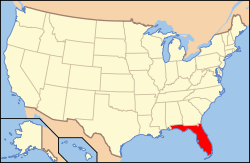Whitehall (Henry M. Flagler House)
Whitehall is a 75-room Gilded Age mansion open to the public in Palm Beach, Florida in the United States. Completed in 1902, it is a major example of neoclassical Beaux Arts architecture designed by Carrère and Hastings for Henry Flagler, a leading captain of industry in the late 19th century, and a leading developer of Florida as a tourist destination. The building is listed[4] a National Historic Landmark. It now houses the Flagler Museum, named after its builder.
Whitehall (Henry M. Flagler House) | |
 Henry M. Flagler Mansion | |
 | |
| Location | Palm Beach, Florida, USA |
|---|---|
| Coordinates | 26°42′51″N 80°2′30″W |
| Built | 1900–1901[1][2] |
| Architect | Pottier & Stymus, Carrère and Hastings[1][3] |
| Architectural style | Beaux Arts[1] |
| NRHP reference No. | 72000345[3] |
| Significant dates | |
| Added to NRHP | December 5, 1972 |
| Designated NHL | February 16, 2000[2] |
History
Henry Flagler, one of the founders of Standard Oil, built Whitehall for his third wife, Mary Lily Kenan.
The site of the home was purchased for $50,000 in 1893 (as of 2010 that would be $1,197,562.39) by Flagler; later surveyed for construction in July 1900 and the home completed in time for Flagler and his wife to move in on February 6, 1902.[5] The architects were Carrère and Hastings, who had earlier designed the Ponce de Leon Hotel and several other buildings in St. Augustine for Flagler. Whitehall was to be a winter residence, and Henry gave it to Mary Lily as a wedding present. They would travel to Palm Beach each year in one of their own private railcars, one of which was No. 91.
Flagler died of injuries sustained in falling down a flight of marble stairs at Whitehall in 1913, at the age of 83.[6][7] Mary Lily died four years later, and the home was devised to her niece Louise Clisby Wise Lewis, who sold the property to investors. They constructed a 300-room, ten-story addition to the west side of the building, obliterating Mr. Flagler's offices, the housekeeper's apartment, and altering the original kitchen and pantry area.[5] Carrere and Hastings were the architects of the 1925 reconstruction. In 1939 it was described as a $4,000,000 building and Palm Beach's second-largest hotel.[8]
In 1959, the site was saved from demolition by one of Henry Flagler's granddaughters Jean Flagler Matthews. She established the Henry Morrison Flagler Museum non-profit corporation, which purchased the building in 1959, opening it as a museum in 1960. The upper ten stories of the hotel addition were demolished in 1963 in preparing the museum for the public.[5]
Today, Whitehall is a National Historic Landmark and is open to the public as the Flagler Museum, featuring guided tours, changing exhibits, and special programs. It also hosts a variety of local galas and balls throughout the year. The Museum is located at Cocoanut Row and Whitehall Way, Palm Beach.
Architecture


When it was completed in 1902, Whitehall was hailed by the New York Herald as "more wonderful than any palace in Europe, grander and more magnificent than any other private dwelling in the world." It was designed in the Beaux Arts style; meant to rival the extravagant mansions in Newport, Rhode Island.[9]
Distinct from these northern homes, Whitehall had no outbuildings or subsidiary structures. Nor had it elaborately planned or cultivated gardens. Plants, flowers, trees and shrubs were allowed to grow unaided.[10]
The mansion is built around a large open-air central courtyard and is modeled after palaces in Spain and Italy. Three stories tall with several wings, the mansion has fifty-five fully restored rooms furnished with period pieces. These rooms are large with marble floors, walls and columns, murals on the ceilings, and heavy gilding.[9]
Flagler Kenan Pavilion
Officially opened February 4, 2005, the $4.5-million Flagler Kenan Pavilion is the first addition to the property since 1925.[11] The 8,100-square-foot (750 m2) pavilion is named after the mogul and William R. Kenan, Jr., Flagler's engineer, friend and brother-in-law. It was designed in the Beaux-Arts manner by Jeffery W. Smith of Palm Beach-based Smith Architectural Group, Inc. and took almost four years to build. The featured display in this pavilion is Flagler's restored No. 91 rail car. It also houses the seasonal Pavilion Café.[12]
See also
- Largest Historic Homes in the United States
- List of Gilded Age mansions
- List of National Historic Landmarks in Florida
References
- Ossman, Laurie; Ewing, Heather (2011). Carrère and Hastings, The Masterworks. Rizzoli USA. ISBN 9780847835645.
- "Flagler Museum – Whitehall". Archived from the original on 2008-04-07.
- Whitehall (Henry M. Flagler House) Archived 2009-05-02 at the Wayback Machine at National Historic Landmarks Program Archived September 27, 2007, at the Wayback Machine
- "National Register Information System". National Register of Historic Places. National Park Service. July 9, 2010.
- National Register of Historic Places Travel Itinerary accessed on June 13, 2006
- Historic American Buildings Survey Library of Congress
- "Whitehall Flagler Museum". Destination 360. Retrieved 2010-04-04.
- "Henry Morrison Flagler". Everglades Digital Library. Retrieved 2010-04-04.
- Federal Writers' Project (1939), Florida. A Guide to the Southernmost State, New York: Oxford University Press, p. 232
- http://www.nps.gov/nr/travel/geo-flor/36.htm National Park Service
- The American Country House, Clive Aslet, Yale University Press, 2005 pg. 222
- Palm Beach Post; January 16, 2005; Sunday ARTS AND ENTERTAINMENT; Pg. 6J
- Florida Design A Grand Home For Flagler's Railcar
External links
| Wikimedia Commons has media related to Whitehall (Henry Morrison Flagler Museum). |
- Official website
- National Historic Landmarks Survey, March 29, 2004, reproduced as a specimen application for listing (accessed June 13, 2006)
- Palm Beach County listings at Florida's Office of Cultural and Historical Programs
- Historic American Buildings Survey (HABS) No. FL-224, "Henry M. Flagler Mansion, Whitehall Way, Palm Beach, Palm Beach County, FL", 24 photos, 1 color transparency, 2 measured drawings, 34 data pages, 3 photo caption pages, supplemental material

